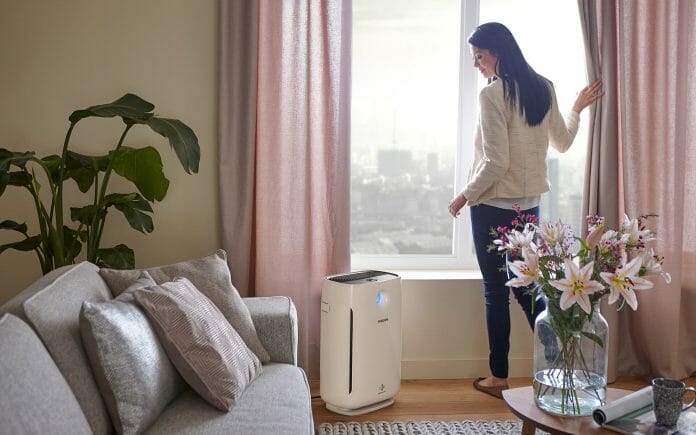According to the Environmental Protection Agency (EPA), the levels of indoor air pollutants can be two to five times higher than the outdoors, and lockdowns have exacerbated that even further.
In fact, the World Health Organisation (WHO) revealed that around 3.8 million people a year die from exposure to household air pollution. Poor indoor air quality has been linked to a range of illnesses, including asthma, pneumonia, lung cancer, chronic obstructive pulmonary disease, and cardiovascular disease.
The above-mentioned reports highlight the importance of air purification, especially during the current climate where most diseases are airborne. Air purifiers are vastly seen in many places nowadays as the awareness of having air purifiers to help keep indoor air clean has increased exponentially.
The German Environment Agency’s (Umweltbundesamt) recommendations on the use of portable air purifiers as air ventilation supporting measure for SARS-CoV-2 in schools states that the air purifier used in a recent study (the Philips Air Purifier 2000 Series AC2887/30) was able to partially remove viruses from the indoor atmosphere.
Nicholas Lee, Personal Health Leader of Philips ASEAN Pacific shares that a study from the Goethe University of Frankfurt am Main reported that four Philips Air Purifier 2000 Series AC2887/30 operating in a classroom with 27 students can remove 90 percent of aerosols within 30 minutes.

“This is an indication of the awareness within specific groups on the importance of air purifiers and how it helps students concentrate in school, leading to improved performance. Overall, there is an increased demand for air purifiers driven by the pandemic and the awareness around how we can improve the quality of air that we breathe,” he explains.
The research, Demystifying a Possible Relationship between Covid-19, Air Quality, and Meteorological Factors: Evidence from Malaysia proved that highly polluted regions lead to higher Covid-19 cases.
Speaking on the difference in demand in Singapore and Malaysia after the pandemic, Lee says that there is an increase in awareness and demand by both companies and consumers. Moreover, Governmental agencies, fitness studios, schools, restaurants, hotels, and resorts have reached out to Philips for bulk purchases.
“With societies opening up, consumers want to feel reassured that organisations are taking greater responsibility for their health and safety by installing air purifiers to ensure purification of the indoor air.
Electronic retailers and e-commerce partners have also seen a significant increase in demand for Philips air purifiers which indicates that consumers are concerned about indoor air quality,” he adds.
Philips recognises that air purifiers have had a more functional appearance in the past and launched the new 3000i Series which features a great overall design for 360-degree airflow and fits well in living rooms, showrooms as well as fitness studios.
Philips Air Purifiers contain NanoProtect HEPA filters which are the preferred choice and can remove 99.97 percent of particles as small as three nanometers (0.003μm), smaller than the smallest known virus, from the air which passes through the filter.
HEPA filters are safer and more effective than ultraviolet (UV) devices and ionising air cleaners. UV radiation is harmful to humans and ionising air cleaners produce ozone which is harmful to the environment.
“An important aspect that we should also look at for air purifiers is its Clean Air Delivery Rate (CADR), which looks at how efficient the air purifier is, and how much clean air can circulate within that environment at any given point in time.
The higher CADR the more air is purified and the faster the air is cleaned. Philips NanoProtect HEPA has a higher CADR, where it cleans the air faster, cleaning more air particles for the same amount of time and is better for dealing with high pollution events and high pollution environments,” Nicholas elaborates.
According to Nicholas, consumers also want to furnish their house beautifully, apart from the functionality of products. Therefore the design aspect of Philip’s innovations is a core area of focus.
Aside from the NanoProtect HEPA filters, some other innovations related to the air purifiers include:
Philips VitaShield IPS technology – an industry-leading, multistage, active filtration system that has a high-efficiency rate in the removal of airborne allergens.
AeraSense – an advanced, professional-grade gas and particle sensor that accurately identifies airborne pollutants even smaller than PM2.5.
The Philips Clean Home+ app – allows consumers to check indoor and outdoor air quality, pollution alerts, and pollen count. In the future, we will see this sharing of information around clean air connecting communities, ensuring that everyone is up to date on the air that they breathe. The App also provides us with information on how much life your filter has left for effortless maintenance.
“These technologies, combined with the Philips Clean Home+ app, allow us to better understand both our indoor and outdoor air quality and demonstrate our leadership in innovation.
We see HEPA filters as the benchmark for performance, where it has similar performance to those used to keep the air clean in hospital operating rooms and industrial clean rooms. These filters are very effective at trapping microscopic particles as small as bacteria and viruses,” he concludes.









